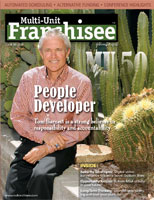Automated Assistance: Employee Scheduling Systems Optimize Scheduling, Cut Turnover, Reduce Costs
While there are many good reasons to implement an automated employee scheduling system (two of the more obvious being to control labor costs and improve customer service), few employers realize that there are two additional important benefits to be realized.
The first is how these systems reduce employee turnover. The second is how they make your managers' jobs far easier.
These kinds of systems reduce costly employee turnover because your best people are usually the ones who prefer to be kept busy. These systems do just that by optimizing schedules to synch perfectly with demand. Many of these systems also take into account each employee's preferred working hours and days so your people feel more in control of their lives. Both the workaholics and the part-timers get to enjoy the work/life balance they want. Many also allow employees to schedule vacations, time off, and to swap shifts on their own.
All these "employee benefits" create a sense of empowerment—as well as personal accountability—that reduces any cause for complaint, keeps your best people on board and motivated, and simplifies the work your managers have to do to keep operations staffed at optimized levels.
Once upon a time, not so long ago really, employee scheduling was a tedious and time-consuming task that required frontline managers to perform a complex balancing act. Just a few of the factors thrown into the mix were employee availability and skills, sales/traffic patterns, labor laws, seasonal or special promotions, seniority, and absenteeism. The sheer number of complex variables, however, is what makes the employee scheduling task perfectly suited to computing power. And today, organizations of all sizes can choose from a myriad of employee scheduling solutions to meet their needs.
Depending on the size of your workforce and number of locations, you can download free Excel spreadsheets or buy simple, yet powerful programs for less than $100. Larger employers can purchase traditional software license agreements for in-house or web-based solutions. Still others turn to consultants to analyze all store activities and do time studies to develop fully customized systems integrated with their existing HR, payroll, and POS systems.
As with any innovation, there has been a natural evolution of scheduling system improvements over the years. In the 1990s, many employers developed home-grown systems based on DOS, Windows, or Unix, but these systems were costly to own, maintain, and upgrade. The emergence of specialized vendors offering focused expertise (staffed in large part by personnel with retail operations experience) and an ability to spread their costs over numerous clients has made their systems the favored choice for most today.
While you many not need all the bells and whistles available from these vendors, here's a summary of some of the features you may want to look for, or add to what you now use:
- Forecast volume/activity and recommend staffing levels by job title (in as little as quarter-hour increments)
- Coordinate multiple schedules for multiple locations
- Factor in employee availability/preferences
- Track vacation and sick leave hours and balances
- Create reports (Payroll Percentage of Sales, Average Transaction Size, Average Wage Rate, Sales per Labor Hour, etc.)
- Comply with company policy, labor laws, insurance and tax rules and regulations
- Schedule an employee for more than one shift or split shifts per day
- Print schedules
- Create more accurate sales and labor budgets
- Schedule appointments and meetings
- Allow employee input
- Data import/export
- Data backup and restoration
- Ability to respond to seasonal/promotional changes and business growth
One franchise operation making the move to a more sophisticated, automated scheduling system reports that they're starting to see benefits even in the beta stage; and that the franchisees participating in the rollout are finding the system more accurate and effective by far when it comes to controlling labor costs.
It's been quite a concerted effort to get to this stage, though. Consultants were brought in to look at the floor operation and analyze each person's role and the time it takes to do every task. Then, with all that data in the system, they were able to optimize not only the number of people working, but ensure that the right people—those with the necessary skills and/or training—are in the right roles and that no one is sitting on their hands.
Because it's been found that the young people who typically work at their stores are tech-savvy, the company plans to have a website where employees can manage their own schedules. In effect, they take ownership of the responsibility and relieve the owner/managers of what used to be an incredibly time-consuming task.
When you ask consultants and vendors of automated employee scheduling systems about the obstacles or resistance they've had to overcome with clients in the past, there is a strong, independent consensus that success requires 1) 100 percent buy-in and backing by top management; and 2) a strong project leader who can educate frontline managers to the benefits of these systems and act as a liaison when it comes to overcoming any resistance to change and perceived threats to local autonomy.
However, this kind of concerted effort can have a tremendous return on investment. One vendor told us his clients routinely experience a 15 to 32 percent drop in labor costs.
Because the employee workforce is usually the largest controllable expense (as well as the most strategic asset) of every business, optimized employee scheduling systems enable today's employers to better balance the needs of their business, customers, and employees, creating a win-win-win situation—as well as a great way to minimize costly employee turnover and free your frontline managers for more important tasks.
If you would like a list of some of the vendors who provide such systems, feel free contact me.
Mel Kleiman, CSP, is an internationally recognized consultant, author and speaker on strategies for hiring and retaining the best frontline employees. He is president of Humetrics, a leading developer of systems, training, processes, and tools for recruitment, selection, and retention of the hourly workforce. He is the author of five books, including the best-selling Hire Tough, Manage Easy. Find him at (713) 771-4401, mkleiman@humetrics.com, or at www.kleimanhr.com.
Share this Feature
Recommended Reading:
Comments:
comments powered by DisqusFRANCHISE TOPICS
- Multi-Unit Franchising
- Get Started in Franchising
- Growth
- Operations
- Open New Units
- Leadership
- Marketing
- Technology
- Legal
- Awards
- Rankings
- Trends
- Featured Franchise Stories
FEATURED IN

Multi-Unit Franchisee Magazine: Issue 3, 2008
$125,000
$750,000




 The multi-unit franchise opportunities listed above are not related to or endorsed by Multi-Unit Franchisee or Franchise Update Media Group. We are not engaged in, supporting, or endorsing any specific franchise, business opportunity, company or individual. No statement in this site is to be construed as a recommendation. We encourage prospective franchise buyers to perform extensive due diligence when considering a franchise opportunity.
The multi-unit franchise opportunities listed above are not related to or endorsed by Multi-Unit Franchisee or Franchise Update Media Group. We are not engaged in, supporting, or endorsing any specific franchise, business opportunity, company or individual. No statement in this site is to be construed as a recommendation. We encourage prospective franchise buyers to perform extensive due diligence when considering a franchise opportunity.